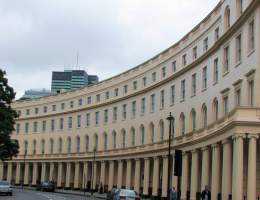 Nash's Park Crescent.
Nash's Park Crescent.
In Great Portland Street, close to the station, is the modern Portland Hospital. In a niche in the front wall is a modern sculpture Mother and Child (by David Norris, presumably dating from 1983, when the building was put up). The child is balanced on the motherís arm, and she leans far over to accommodate his weight, giving a dynamic feeling to the group. The faces lack somewhat, but a graceful effect is achieved. From the station, turning left along Marylebone Road brings one immediately to the entrance to Park Crescent, an elegant collonaded Nash construction, satisfying to the eye. (Going further along the road would take us to Marylebone Parish Church.) Walking down the Crescent to the centre, is the beginning of Portland Place - this was all part of the massive town planning scheme of wide Champs-Elysee style boulevards running from Regents Park through Regent Street and thence to the north side of St James's Park. It resulted in some grand architecture, but was never completed, due to lack of funds, and somehow planning on this scale does not really feel appropriate to London. Facing down Portland Place, many grand Georgian blocks survive, and there is indeed a grand elegance to this remarkably wide avenue, but it has a certain coldness and oversizedness which is difficult to feel at home with. I am grateful that we can see a road like this in London, but rather more grateful that there are not too many other things like it in London.
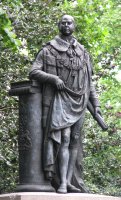 Sebastian Gahagan's Prince Edward, Duke of Kent.
Sebastian Gahagan's Prince Edward, Duke of Kent.
Anyway, facing down Portland Place from the private gardens in the Crescent, is a statue from the 1820s when the scheme was put in place, and thus one of the earlier statues in London surviving in its original setting. It is of Prince Edward, Duke of Kent, and is a work of the sculptor Sebastian Gahagan. It almost seems to belong to the 18th Century rather than the early 19th, and is a world away from a Victorian conception. The subject has a somewhat portly look, and is effectively clad in heavy drapery over tights, and although this reflects a conception of the time that the male leg was an object of beauty and should be displayed, to modern eyes this statue lacks something of dignity, and is imparted a rather top-heavy appearance when viewed from the front, as opposed to the better three-quarter view. In its detail, though, it is a skillful work by an artist whom we have little enough opportunity to appreciate. It is signed towards the base of the pillar.
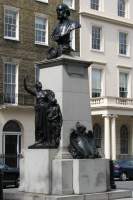
 Joseph Lister monument, by Thomas Brock.
Joseph Lister monument, by Thomas Brock.
In Portland Place itself, the first monument is a large bust of Joseph Lister (1922), a surgeon who promulgated important advances in the use of sterile conditions for surgery, to huge benefit to public health. His portrait bust stands on a high pedestal with bronze garnishes on the sides and a lifesize group of a woman and boy at the front. The bust is a characterful portrait with sideburns, reminiscent of Thomas Huxley. The figure and drapery of the woman is most graceful. The artist was Thomas Brock, and a foundry stamp notes that the work was cast by Morris Art Bronze Foundry, London SW8.
Going down Portland Place, at the end of the block is a crossing with Devonshire Street, and the entrance to the block on the corner, opening to Devonshire Street, has two amusing little reclining dragons (one is at the bottom of this page) and a more conventional bearded head keystone which are worth a glance.
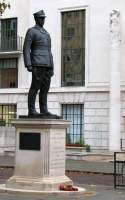 Sikorski, by Faith Winter, and behind, a female figure by James Woodford.
Sikorski, by Faith Winter, and behind, a female figure by James Woodford.
Back in Portland Place and continuing south until the crossing with Weymouth Street, we have the modern statue of General Sikorski, leader of the exiled Polish Government during WW2, a better than average work by Faith Winter. On the building to the left of him is the RIBA (Royal Institute of British Architects) building, no. 66, a 1930s pile adorned by architectural sculpture of stylised nude figures in stone, by James Woodford. Two free standing nude figures, male and female, on pillars and a high relief work. Round the side on Weymouth Street are five more figures in high relief by E. B. Copnall.
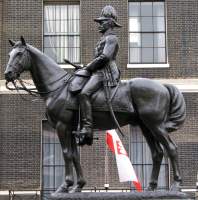 Equestrian statue of George Stuart White.
Equestrian statue of George Stuart White.
On the other side of the Weymouth Street junction, we have a further statue from the early 20th Century: an equestrian George Stuart White (1922), by John Tweed. A fairly impressive work, which like so many equestrian portraits, is seen to best advantage in absolute profile. (Views of this statue, and other equestrian statues, are on the horse statues for drawing page.) Continuing, our last bronze is Quintin Hogg, founder of the Polytechnic Movement, by Frampton dating from 1906. The group consists of Hogg, seated, reading from a book to two serious and attentive youths - a harmonious composition from all angles.
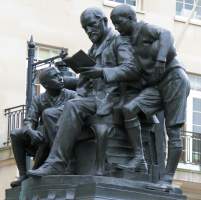 Quintin Hogg, by George Frampton.
Quintin Hogg, by George Frampton.
From this vantage, ahead, the road angles to the left, and filling the view is the enormous bulk of a 19th century hotel, the Langham, of prodigious size, and the road now becomes Langham Place. The large block on the left as the road arcs round to bypass the hotel is the BBC's Broadcasting House, not so recognisable from this view, built at the end of the 1920s. It bears contemporary stone sculpture, of Ariel between stylised angels representing Wisdom and Gaiety, by Eric Gill, and at the end towards the church, above the main entrance, a free standing colossal group of Prospero and Ariel, again characteristic work by Gill, with Prospero a figure robed in stylised Byzantine costume, and Ariel as the naked figure in front holding some sort of small panpipe.
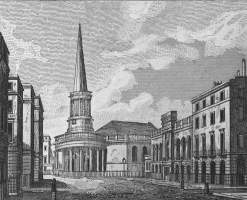 All Souls Langham Place, by John Nash.
All Souls Langham Place, by John Nash.
The church which marks the point where the road switches back towards its original course is All Souls Langham Place, and its many-columned rotunda gives the distinctive view when looking north from Oxford Circus. The church dates from 1822-4 and forms part of the original development of the street by John Nash. It is a marvellous exterior, despite the unlikely combination of the classical forms with an essentially Gothic spire on top. The interior, a pillared blocky hall with a gallery, contains an important painting, Ecce Home, by Richard Westall. Against the exterior wall is a modern bust of Nash.
By the church on the left hand side, and thus away from the Langham Hotel, is Riding House Street; we may note the panels high up, showing two male and four female standing figures, swirly art nouveau creatures - the date 1914 is next to one of them, making them late for their style. The next road along on the left is Mortimer Street - the second building along, no. 82 (though no 90 is next door), is by the interesting architect Beresfort Pite, much enamoured of architectural sculpture, and above the second floor are two caryatid figures in stone, male and female, supporting a small pediment above the central window. These sculptures are apparently by Farmer and Brindley, though I have not been able to confirm this. Lots more Caryatid figures on this page.
Mortimer St caryatids, and panels on 82 Riding House Street.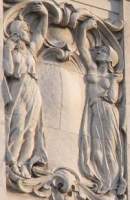
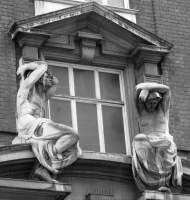
This is the end of the Portland Place perambulation - Langham Place becomes the upper end of Regent Street, and takes us in a couple of minutes further to Oxford Circus, Oxford Street and the main part of Regent Street. Alternatively, the road off Langham Place on the right hand, opposite side to Mortimer Place is Wigmore Street, leading to Cavendish Square and the interesting decorated Debenhams building; and the next road but one to the left parellel to Mortimer Street is Margaret Street, leading to Butterworth's extravagantly decorated All Saints Church.
London sculpture // Sculpture pages
Visits to this page from 13 Mar 2014: 10,242